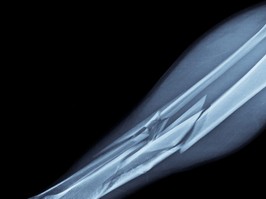advancing bone grafts: hydrogel research unlocks new potential for regrowth
while still in the research phase, the invention of the new hydrogel paves the way for better bone grafting technologies in the future.

bone grafts are required in several instances, such as to repair or replace bone lost due to disease, trauma from fractures or breaks, or infections.
getty images
your bones carry the weight of your body, so when one or more of them are not fully formed, or someone loses some of their bone, it can cause various issues. these, often referred to as bone defects, can develop for many reasons, including the natural aging process, trauma or infection, or they can exist at birth.
bone grafts are typically used to help fill in the missing pieces, but new research from pohang university of science & technology in pohang, south korea, has found a way to increase bone regeneration that can go beyond the limits of traditional bone grafts.
researchers have developed an injectable hydrogel containing harmless visible light, fostering a better bonding process and hardening into the empty space.
bone loss and grafts
bone grafts are required in several instances, such as to repair or replace bone lost due to disease, trauma from fractures or breaks, or infections. these grafts are combined with bioadhesives or serums to help fill the defect in the bone, restoring it to full functionality.
currently, while bone grafts are effective, there are certain limitations to the technology, including:
- possible bleeding, infection, or nerve damage
- the quality of the new bone isn’t always where it should be
- bone graft rejections, where the body rejects the new material
- shrinkage of the graft, leading to loss of bone density
- failure to regenerate and adhere to the existing bone
advertisement
these limitations led to researchers looking for a better, more viable way to fix these defects.
the latest hydrogel
the team of researchers from pohang university of science and technology was led by professor hyung joon cha from the school’s department of chemical engineering and graduate school of convergence science and technology.
their main goal was to look at the limitations found in bone graft technology and improve upon them so that people who need these procedures will have better outcomes. that is when they came up with their hydrogel, made up of a natural polysaccharide derived from brown algae, an rgd peptide-containing mussel adhesive protein, calcium ions, phosphonodiols, and a photoinitiator to deliver unharmful light to the area. the finished product can, when injected, fill the empty space in the bone and retain its shape better due to its inability to mix with water content within the body.
after being injected into the area, the hydrogel also emits light that helps the bone and the graft link together molecularly using the calcium ions within the gel, leading to better bone adhesion and regeneration. this additional light is a key player in the efficacy of the new hydrogel, taking bone grafting to a new level.
advertisement
animal models showing success
to determine whether the hydrogel would work as intended, the team selected animals as participants for their study. these animals had femoral bone defects that would benefit from bone grafting technology.
during these tests, the hydrogel was injected into the femoral defects, effectively showing the first step in the success of the new gel-based treatment modality.
after injection, the substance was also able to adhere to the existing bone without any added adhesive and delivered much-needed components that foster bone regeneration, stimulating new bone growth for an even more optimal result.
“the injectable hydrogel system for bone regeneration developed by our research team represents an innovative alternative to conventional complex treatments for bone diseases and will greatly advance bone tissue regeneration technology,” said professor cha in a press release published in science daily.
what this means for patients requiring bone grafts
while still in the research phase, the invention of the new hydrogel paves the way for better bone grafting technologies in the future.
patients who may require these bone grafts and have more complex cases or have undergone the bone graft procedure only to experience rejection or shrinking may benefit from the new gel.
advertisement
because it moulds with the existing bone, retains its shape, and drives bone regeneration using minerals such as calcium, more people with complex bone loss or defects can get one bone graft without having to worry about the limitations of current bone graft technologies.
 3 minute read
3 minute read





